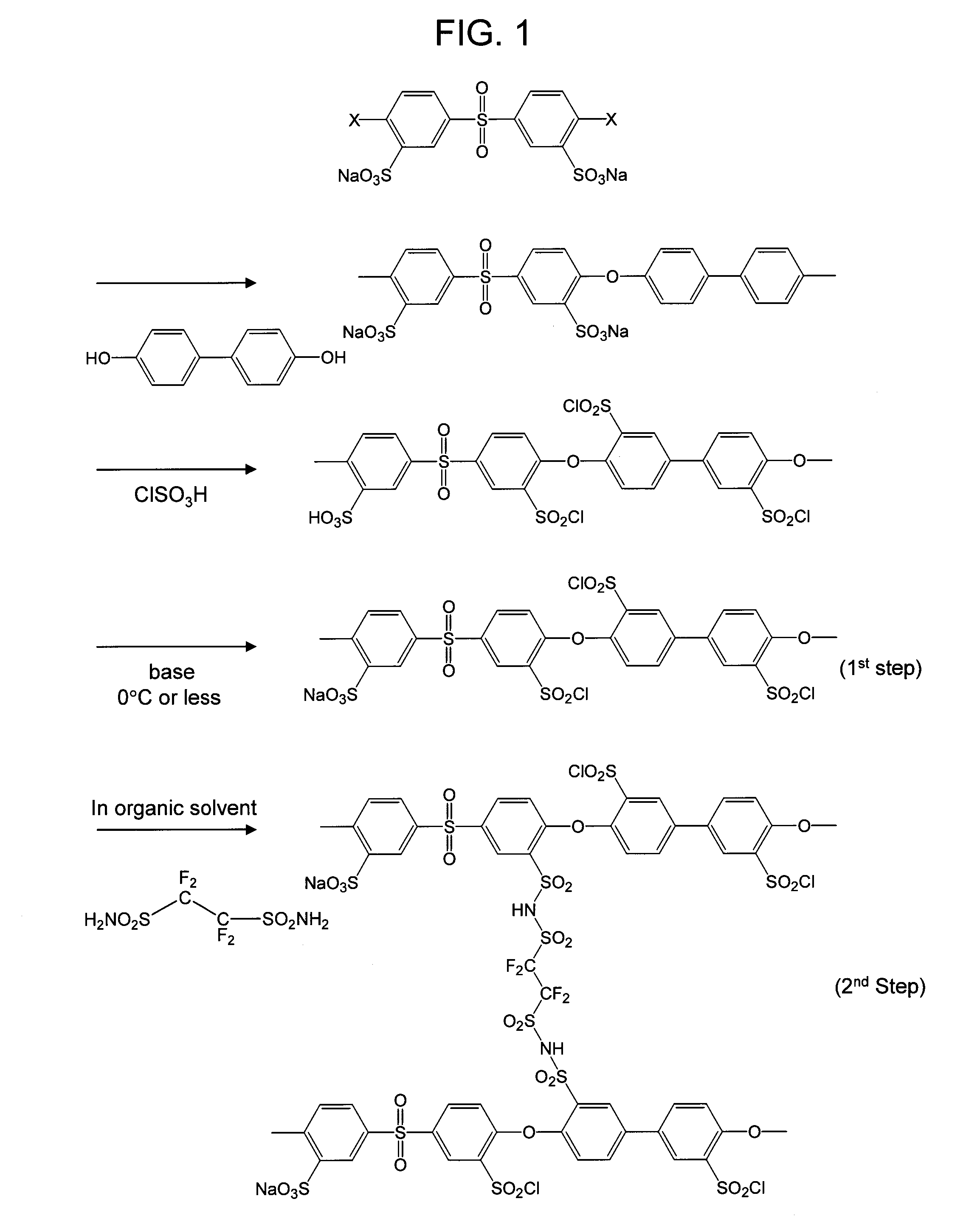Method for synthesizing Polymer Electrolyte, Polymer Electrolyte Membrane, and Solid Polymer Electrolyte Fuel Cell
- Summary
- Abstract
- Description
- Claims
- Application Information
AI Technical Summary
Benefits of technology
Problems solved by technology
Method used
Image
Examples
example 1
[0039]A polyether sulfone-based sulfonated polymer shown in FIG. 1 was added in small amounts to a 100-ml eggplant flask containing 50 ml of chlorosulfuric acid (NACALAI TESQUE, INC.) while maintaining a temperature of 0° C. After warming to room temperature, complete dissolution was confirmed and then the temperature was raised to 110° C. After 6 hours, the temperature was lowered to 70° C., 10 ml of thionyl chloride (NACALAI TESQUE, INC.) was added while maintaining the temperature, and then the resultant was held for 1 hour while refluxing.
[0040]After cooling to room temperature, the resultant was added dropwise to a large amount of ice water and 10 wt % baking soda and precipitation was formed again. After completing the dropwise addition, an appropriate amount of baking soda was added again, and pH was adjusted to weak alkaline conditions, pH 7 to 8, so that remaining acids was completely removed. The resultant was subjected to separation by filtration under reduced pressure wh...
example 2
[0043]1 g of a polymer (number average molecular weight: 24000) containing polyphenylene synthesized by a Diels-Alder reaction as a basic structure was added to a 50-ml eggplant flask containing a glass stirrer. Then, 20 ml of high purity concentrated sulfuric acid (>98%, Kanto Chemical Co., Inc.) was added and then the resultant was heated using a mantle heater to 290° C. After 3 hours of reaction, the temperature was cooled to room temperature. Then the resultant was added dropwise to 200 ml of dehydrated diethyl ether (Kanto Chemical Co., Inc.) cooled to −10° C. under an N2 atmosphere, so that precipitation was carried out again. After 3 hours, powder was collected by filtration under reduced pressure, added again to 200 ml of dehydrated diethyl ether+dehydrated acetonitrile (volume ratio of 7:3) under an N2 atmosphere, and then washed.
[0044]After 2 hours, filtration under reduced pressure was carried out and then vacuum drying was carried out at 60° C., so that a brownish-red po...
PUM
| Property | Measurement | Unit |
|---|---|---|
| Temperature | aaaaa | aaaaa |
| Volumetric flow rate | aaaaa | aaaaa |
| Pressure | aaaaa | aaaaa |
Abstract
Description
Claims
Application Information
 Login to View More
Login to View More - Generate Ideas
- Intellectual Property
- Life Sciences
- Materials
- Tech Scout
- Unparalleled Data Quality
- Higher Quality Content
- 60% Fewer Hallucinations
Browse by: Latest US Patents, China's latest patents, Technical Efficacy Thesaurus, Application Domain, Technology Topic, Popular Technical Reports.
© 2025 PatSnap. All rights reserved.Legal|Privacy policy|Modern Slavery Act Transparency Statement|Sitemap|About US| Contact US: help@patsnap.com


